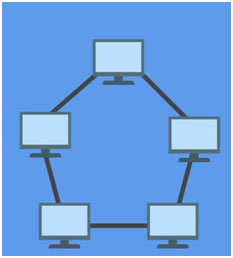Network Topology
A network topology is the arrangement of nodes– generally switches, routers, or software switch/router features– and connections in a network, frequently represented as a chart. The topology of the network and the relative places of the source and location of traffic flows on the network, figure out the optimum path for each circulation and the level to which redundant choices for routing exist in case of a failure.
The physical topology of a network is the layout of nodes and physical connections, including wires (Ethernet, DSL), fiber optics, and microwave.
Types of Physical Topology
There are 6 types of topology in computer networks:
- Mesh Topology
- Star Topology
- Bus Topology
- RingTopology
- Hybrid Topology
- Tree Topology
Mesh Topology
In a mesh topology, each device is linked to every other device on the network through a devoted point-to-point link. When we say dedicated it means that the link only brings data for the two linked devices just. Let’s say we have n devices in the network then each device should be gotten in touch with (n-1) devices of the network. A number of links in a mesh topology of n devices would be n(n-1)/ 2.

There are two methods to transmit data over the Mesh topology, they are:
- Routing
- Flooding
Mesh Topology: Routing
In routing, the nodes have a routing logic, as per the network requirements. Like routing logic to direct the data to reach the destination using the quickest range. Or, routing logic which knows about the broken links, and it avoids those nodes and so on. We can even have routing logic, to re-configure the failed nodes.
Mesh Topology: Flooding
In flooding, the very same information is transferred to all the network nodes, for this reason, no routing logic is required. The network is robust, and it’s really unlikely to lose the data. However, it results in unwanted load over the network.
Benefits of Mesh topology:
- Reputable: The mesh topology networks are really dependable as if any link breakdown will not impact the interaction between linked computer systems.
- Fast Communication: Communication is extremely fast between the nodes.
- Easier Reconfiguration: Adding new devices would not interfere with the communication between other devices.
Disadvantages of Mesh topology
- Cost: A mesh topology includes a large number of linked gadgets such as a router and more transmission media than other topologies.
- Management: Mesh topology networks are very large and very difficult to manage and handle. If the network is not kept track of thoroughly, then the communication link failure goes undetected.
- Efficiency: In this topology, redundant connections are high that minimizes the performance of the network.
Star Topology
In star topology, all the gadgets are connected to a single hub through a cable. This center is the central node and all other nodes are linked to the main node. The center can be passive in nature i.e., not an intelligent hub such as broadcasting devices, at the same time the center can be intelligent called active hubs. Active hubs have repeaters in them.
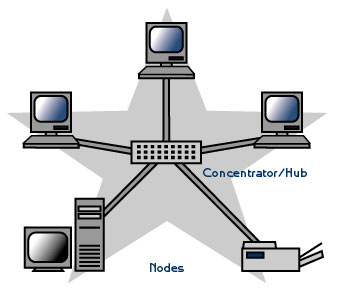
Benefits of Star topology:
- If N gadgets are connected to each other in star geography, then the number of cables required to link them is N. So, it is easy to set up.
- Each gadget requires just 1 port i.e., to link to the hub.
Drawbacks of Star topology:
- If the hub on which the whole topology relies stops working, the entire system will crash down.
- The cost of setup is high.
- Efficiency is based upon the single concentrator i.e., hub.
Ring Topology
It is called ring topology since it forms a ring as each computer system is linked to another computer, with the last one connected to the very first. Precisely two neighbours for each device. A variety of repeaters are used for Ring topology with many nodes, due to the fact that if somebody wishes to send some data to the last node in the ring topology with 100 nodes, then the data will have to travel through 99 nodes to reach the 100th node.
Thus, to prevent information loss repeaters are used in the network. Data is transferred in a consecutive way that is bit by bit. Data transmitted, has to go through each node of the network, till the final node.
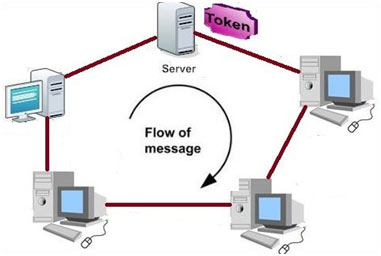
Advantages of Ring topology
- Transmitting network is not impacted by high traffic or by including more nodes, as only the nodes having tokens can send information.
- Cheap to install and expand
Disadvantages of Ring topology
- Repairing is hard in a ring topology.
- Including or removing the computers disrupts the network activity.
- Failure of one computer system disturbs the entire network.
Bus Topology
In a bus topology, there is the main cable and all the gadgets are linked to this primary cable through drop lines. There is a device called tap that connects the drop line to the main cable. Given that all the data is transferred over the primary cable, there is a limitation of drop lines and the distance the main cable can have.
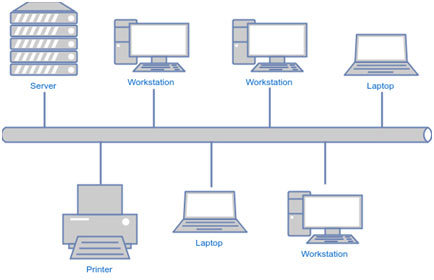
Benefits of Bus topology
- Easy installation, each cable requires to be connected with the backbone cable.
- Less cable required than Mesh and star topology.
Drawbacks of Bus topology
- Difficultly in fault detection.
- Not scalable as there is a limit of how many nodes you can get in touch with backbone cable.
Hybrid Topology
The combination of numerous different topologies is known as Hybrid topology. A hybrid topology is a connection between different links and nodes to transfer the information. When 2 or more different topologies are combined together is described as Hybrid topology and if similar topologies are connected with each other will not lead to Hybrid topology.
For example, if there exists a ring topology in one branch of the ICICI bank and bus topology in another branch of the ICICI bank, linking these 2 topologies will result in Hybrid topology.
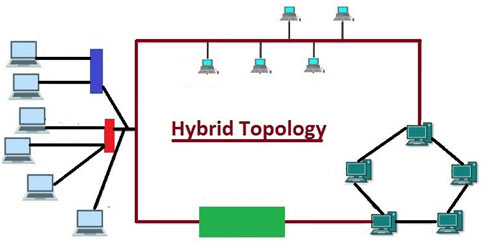
Advantages of Hybrid topology
- Reliable: If a fault takes place in any part of the network will not affect the functioning of the rest of the network.
- Versatile: This topology is extremely versatile as it can be developed according to the requirements of the company.
- Efficient: Hybrid topology is really effective as it can be developed in such a way that the strength of the network is maximized and the weakness of the network is reduced.
Downsides of Hybrid topology
- Complex design: The significant disadvantage of the Hybrid topology is the design of the Hybrid network. It is really hard to develop the architecture of the Hybrid network.
- Expensive Center: The Centers used in the Hybrid topology are really expensive as these centers are different from typical Centers used in other topologies.
- Expensive facilities: The facilities cost is extremely high as a hybrid network requires a great deal of cabling, network devices, and so on.
Tree Topology
This topology is the variation of Star topology. This topology has a hierarchical flow of information. In this, the different secondary hubs are linked to the central hub which contains the repeater.
This information flow from top to bottom i.e., from the central hub to secondary and after that to the devices or from bottom to top i.e., devices to the secondary hub and then to the central hub.

Advantages of Tree Topology
- Extension of bus and star geographies.
- Expansion of nodes is possible and simple.
- Easily managed and kept.
- Error detection is quickly done.
Drawbacks of Tree Topology
- Heavily cabled.
- If more nodes are added maintenance is tough.
- The central hub stops working, the network fails.

